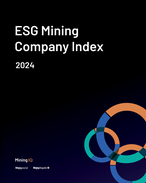Mining company Hochschild recently secured $200 million worth of sustainability-linked loans (SLLs) from BBVA, with funds earmarked for gold and silver mining operations in Peru and Brazil. Noteworthy is the loan's focus on sustainability KPIs revolving around water and waste, even in a climate where carbon is at the forefront of environmental concerns. The industry needs more SLLs focused on things other than carbon.
Carbon is king when it comes to ESG. However, in mining, carbon might be more of a distraction than a centerpiece. Issues related to water and waste loom large in the mining sector and have a significant impact on the industry's social license to operate. The way miners treat water, localized pollutants, tailings and overburden; how they treat communities and share prosperity with them—that's what creates positive impact on lives right now. Alternatively, screwing those things up—that's what sparks community protests that could shutter a mine.
With mines shuttered, the energy transition (so dependent on minerals) sputters. So, things like water and tailings and community prosperity are critical—while they don't directly drive down emissions of miners, they bolster social license, which in turns enables mines to be built faster and stay open once they've been built, which in turns supplies the metals that drive the energy transition forward.
Bearing this in mind, miners need to address more than carbon in SLLs to keep the energy transition rolling.
While miners' broader corporate ESG strategies generally address "non-carbon" issues, SLLs are a different story; SLLs typically center around carbon. Examples include South 32's $1.4b SLL and Teck's $4b revolving credit facility. Newmont linked its loan terms to analysis of its emissions performance by MSCI and S&P.
But more miners need to pursue SLLs linked to non-carbon KPIs that are relevant to local stakeholders, such as:
- Economic development and community prosperity (like Anglo's IFC SLL)
- Effective agreements with artisanal and small-scale miners (like Luminex's agreement in Ecuador)
- Thoughtful mine-closure planning (planning for community prosperity once the mine is gone) and reclamation (planning for the environment once the mine closes)
- Tailings and waste, localized pollution, air quality, and water quality
- Water efficiency and availability of water to local populations
Including these non-carbon KPIs in financial vehicles like SLLs builds social license and is critical to expanding the mining capacity needed to build our new energy system.
Miners need to address more than carbon in SLLs to keep the energy transition rolling.
By maintaining a broad scope of what sustainability means to stakeholders (and engaging in efforts like materiality mapping), companies like Hochschild acknowledge the importance of addressing critical issues to ensure their operations are socially and environmentally responsible—for the people and ecosystems most directly and immediately impacted by miners' operations.
Banks can also play a role in focusing efforts on non-carbon KPIs. Financial institutions can implement a framework that separates, manages, and balances SLLs across two camps: ones with a "global" ESG focus (e.g., carbon), and others with a "local" focus (e.g., water, air, tailings; and even considering "meso-scale" sustainability). Managing these separately can help ensure that the local focus is not neglected.
The Hochschild-BBVA deal is lacking in one area, however: transparency around the goals and methodology. What are the targets? How will they be measured? By whom? Transparency is paramount for sustainable mining practices, especially because trust is such a challenge for miners; their "trust deficit" threatens supply of critical energy transition minerals. It's essential for miners and lenders to communicate clear and measurable goals for sustainability efforts like water and waste management.
Gold Fields' SLL, secured earlier this year, was a model for transparency. The bank's ESG requirements were featured front and centre in its press website ("30% women representation [in the workforce], 80% of water consumed to be recycled/reused, and reducing net Scope 1 and 2 emissions by 30% and absolute emissions by 50%"). This type of clear communication should be the norm. It builds trust among key stakeholders—especially communities who live near operations and tend to distrust the mining sector.
To sum it up, mining chiefs should tie more SLLs to performance on issues like water, localized pollution, and shared/community prosperity - even if it diverts some attention from carbon in mining. In the end, it will do more for reducing emissions by greasing the wheels of the energy transition. Hochschild's sustainability-linked debt initiative is a model for the industry.
By addressing these overlooked aspects of ESG, miners can safeguard their social license to operate and insulate the energy transition from supply chain disruptions. In doing so, they will also establish a harmony between their shareholder-driven ESG initiatives and their social license to operate. It's a complex but worthwhile pursuit if miners want to uphold their energy-transition responsibilities.
Wiles Kase is a senior consultant at Clareo, a Chicago-based global strategy firm for the natural resources, energy, and food industries.

























